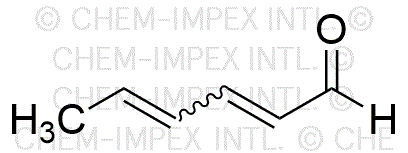2,4-Hexadienal is widely utilized in research focused on:
- Flavor and Fragrance Industry: This compound serves as a key ingredient in the formulation of flavorings and fragrances, providing a fresh, green note that enhances various products, from food items to perfumes.
- Organic Synthesis: It acts as a versatile building block in organic chemistry, allowing researchers to create complex molecules efficiently. Its unique structure facilitates reactions that are crucial in developing new compounds.
- Agricultural Applications: 2,4-Hexadienal is explored for its potential use as a natural pesticide or herbicide, offering an eco-friendly alternative to synthetic chemicals, thus promoting sustainable agricultural practices.
- Biomedical Research: This compound is being studied for its potential anti-cancer properties, with research indicating that it may inhibit the growth of certain cancer cells, making it a candidate for future therapeutic developments.
- Material Science: It is used in the development of polymers and resins, where its reactive double bonds can be utilized to enhance material properties, leading to stronger and more durable products.
General Information
Properties
Safety and Regulations
Applications
2,4-Hexadienal is widely utilized in research focused on:
- Flavor and Fragrance Industry: This compound serves as a key ingredient in the formulation of flavorings and fragrances, providing a fresh, green note that enhances various products, from food items to perfumes.
- Organic Synthesis: It acts as a versatile building block in organic chemistry, allowing researchers to create complex molecules efficiently. Its unique structure facilitates reactions that are crucial in developing new compounds.
- Agricultural Applications: 2,4-Hexadienal is explored for its potential use as a natural pesticide or herbicide, offering an eco-friendly alternative to synthetic chemicals, thus promoting sustainable agricultural practices.
- Biomedical Research: This compound is being studied for its potential anti-cancer properties, with research indicating that it may inhibit the growth of certain cancer cells, making it a candidate for future therapeutic developments.
- Material Science: It is used in the development of polymers and resins, where its reactive double bonds can be utilized to enhance material properties, leading to stronger and more durable products.
Documents
Safety Data Sheets (SDS)
The SDS provides comprehensive safety information on handling, storage, and disposal of the product.
Product Specification (PS)
The PS provides a comprehensive breakdown of the product’s properties, including chemical composition, physical state, purity, and storage requirements. It also details acceptable quality ranges and the product's intended applications.
Certificates of Analysis (COA)
Search for Certificates of Analysis (COA) by entering the products Lot Number. Lot and Batch Numbers can be found on a product’s label following the words ‘Lot’ or ‘Batch’.
*Catalog Number
*Lot Number
Certificates Of Origin (COO)
This COO confirms the country where the product was manufactured, and also details the materials and components used in it and whether it is derived from natural, synthetic, or other specific sources. This certificate may be required for customs, trade, and regulatory compliance.
*Catalog Number
*Lot Number
Safety Data Sheets (SDS)
The SDS provides comprehensive safety information on handling, storage, and disposal of the product.
DownloadProduct Specification (PS)
The PS provides a comprehensive breakdown of the product’s properties, including chemical composition, physical state, purity, and storage requirements. It also details acceptable quality ranges and the product's intended applications.
DownloadCertificates of Analysis (COA)
Search for Certificates of Analysis (COA) by entering the products Lot Number. Lot and Batch Numbers can be found on a product’s label following the words ‘Lot’ or ‘Batch’.
*Catalog Number
*Lot Number
Certificates Of Origin (COO)
This COO confirms the country where the product was manufactured, and also details the materials and components used in it and whether it is derived from natural, synthetic, or other specific sources. This certificate may be required for customs, trade, and regulatory compliance.

